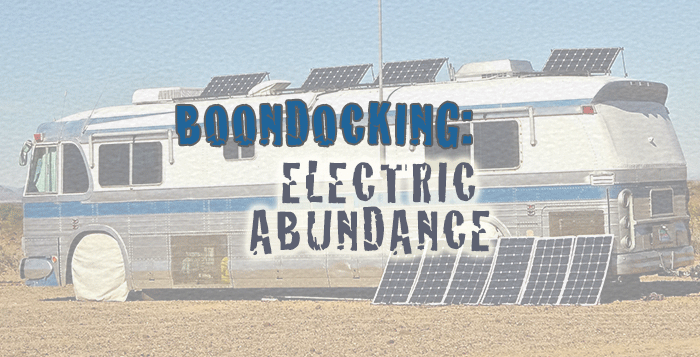
We’ve seen it advised so many times on RVing groups and forums, if you want to boondock – you have to rely on propane for cooking, refrigeration, hot water heating and heating. If your coach is electrically dependent, don’t bother trying to boondock for long.
We say.. phooey to that.
It is entirely possible to feel abundant while off-grid, without relying on propane for a substantial part of our energy needs. It does take a little planning and upfront investment however.
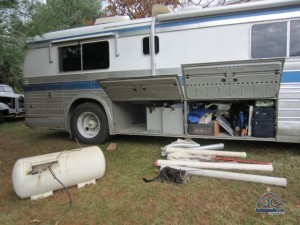
We didn’t exactly set out to have an all-electric coach, but it’s what we ended up with. When we purchased our bus conversion, the propane systems installed in the late 1980s where not smartly engineered, and all of the appliances would have needed a tremendous amount of refurbishing to bring them back to life.
Instead of trying to redesign the propane system from scratch, we opted instead to optimize for electric.
Our fridge is a Vitrofrigo marine fridge equipped with a Danfoss DC compressor. It runs efficiently off 12v DC or 110V AC.
Our primary cooking appliances are electric too – we love our induction cooktop, convection/microwave oven, and new to our kitchen, an Instant Pot electric pressure cooker.
We do have a portable propane space heater for chilly nights, and we do still have the option of heating water off propane if needed. (Summer 2015 Update: We’ve installed a PrecisionTempt TwinTemp Jr. propane hydronic system that provide radiant heat and hot water throughout our coach.)
But given good sun, we’re overflowing with electrons. Toss us a couple cloudy days and we can still manage with minimal of conservation.
So, here’s how we keep feeling energy abundance with our setup while boondocking…
Energy Independence
Of course, boondocking means – no hook-ups. Your coach will need to be energy independent. Whether you choose to rely on a generator or use alternative energy like solar or wind.
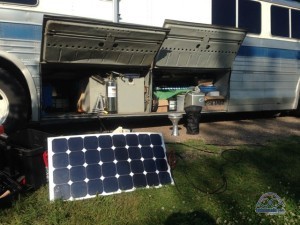
Our choice was building a robust house battery system charged up by the sun. We have 500AH of Lithium Ion Batteries (read our 3.5 year review of them), 1400w of solar (800w permanently mounted on the roof, 600w in portable flexible panels we deploy on the ground) and the Victron Multiplus 3000w pure sine wave inverter.
Obviously, not an insignificant investment to make upfront, and one we didn’t approach without lots of research, planning and thought.
We do have an old janky 7.5kw Onan diesel generator that needs a ton of work before we would want to rely upon it – but it does fire up, and can supply some electrons in a pinch as our backup. (Summer 2015 Update: We removed the 7.5kw diesel generator, and installed a 2.5kw propane generator to use to top up the batteries if needed.)
We pretend it doesn’t exist however, and prefer attempting to live within our solar means.
Our battery bank can also charge from our bus alternator when underway – so we generally arrive to new stops fully charged.
Tip: If you arrive to your next boondocking spot fully charged up – you start ahead of your usage curve. For us, this means for shorter stays of a week or less, we generally don’t even bother tilting our panels.

Know how much energy you need to feel fulfilled while off grid, and plan around it. For us, on top of keeping the electric fridge going, we also have two computers with big screens that we want to keep running well into the wee hours of the morning. Those are our most productive times, so planning around ample energy after sunset is key for us.
Most others more than likely don’t have the same needs however.
Obviously, by not offloading a lot of our energy needs to propane we have to plan in more off-grid electric input and storage than otherwise. But it’s not out of reach.
Related Articles:
- Solar Electrical Systems for RVs
- Lithium Ion Batteries for RV House Systems
- Solar Planning: Conducting An RV Electrical Consumption Audit
Optimize for 12v
An inverter is a key component in a house electrical system for off-grid living. It’s what takes the 12v stored in your house batteries (or 24v if that’s your coach’s system) and converts it to 110 power that most anything you plug into the wall uses. When it’s on, it has a phantom overhead that is constantly sucking power from your batteries, and the conversion process from 12v to 110 has energy loss.
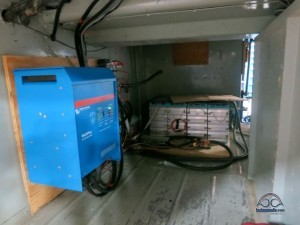
So the more you can reduce reliance on needing an inverter, the more power efficient you can be. Things that can run directly off 12v tap right into the power stored in your batteries and avoid the energy losses of an inverter.
Our main need for 110V AC electricity at this point is our computer monitors, temperature regulation (air conditioner and electric space heaters) and cooking appliances.
Chris uses a laptop and can run independently off that when we don’t have the inverter on. I use a Mac Mini desktop computer hooked to an energy sucking 30″ monitor (which I love.. come on Apple, how about bringing back matte screens, eh??).
But I’m also able to do a lot from my iPad Mini.
The rest of our bus we’ve been optimizing for 12v, so that we can turn off the inverter and still feel abundant. Here’s some of the recent modifications we’ve made to get there:
- 12v Television. We originally installed 22″ LED TV in our bedroom that required 110 power to run. A couple months ago we tracked down a 24″ Samsung TV that we could direct wire into our 12v system. This allows us to watch stuff even after we’ve shut down the inverter. (We currently keep the old 22″ screen around to use a lower power monitor to my 30″ sun sucker when needed.)
-

Installing 12v Charging Stations throughout the bus. 12v USB Charging Stations. Keeping our mobile gadgets charged up is critical. We can get a lot done on our iPads and iPhones without needing to fire up our full fledged computers. We’ve now installed several USB 12v charging stations. This gives us lots of options for keeping the tech happy, as well as our USB charged portable lighting gadgets.
- 12v Lighting. Our bus came with a mix of lighting off 110V AC and 12v DC. We’ve been adding in more 12v lighting to keep our spaces well light regardless of if the inverter is on or off.
- 12v Fans. We have an Fan-Tastic Vent Endless Breeze box fan that runs off 12v that helps keep airflow inside the coach on warmer days (combined with a MaxAir roof vent fan).
We still have a couple more modifications to make, such as powering our NAS (Network Attached Storage) drive off 12v.
Carefully consider your inverter configuration. You need an inverter large enough to handle your typical largest loads (for us, we sized for running 1 air conditioner or cooking appliance – plus computers), but not so large that you have a constant higher than needed phantom draw.
Another strategy is having a large inverter for occasional heavy loads, and then smaller inverters for specific regular tasks. Those with residential fridges (which can’t run on 12v directly) sometimes install a dedicated inverter just for the fridge so they can shut the rest of the coach down.
At some point, we may integrate in a smaller inverter just for our computers… and only using the big inverter when we need to cook or run an A/C.
Shut Down What is Not Needed
When we’re hooked up to the power grid at a RV Park or campground, we pretty much leave stuff on all the time. Computers and hot water heater being our biggies. When we’re off grid, these things get shut down except for when we need them.
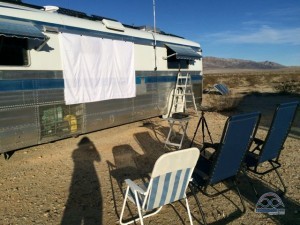
For hot water, we find we really only need to run our 10-gallon hot water heater through one cycle – we can both take ‘Navy Showers’ and get the dishes washed. The rest of the time, we don’t need hot water on tap. When the sun is providing our panels an abundance of photovoltaic activity, we utilize some of the spare energy to heat the water up. On a sunny day, we hardly notice the energy hit at all in the time it takes to get the water up to temperature.
Pre-Plan Cooking Options

When relying on all electric appliances for cooking, meal preparation is directly related to how much solar energy we have available. We have a variety of go-to meals we can prepare – some that require more energy than others.
If we’re abundant in energy for the day, we cook pretty much like we always do. We’ll bake a pizza in the convection oven, or make curry, soups, stir-fries, chili, eggplant parmesan or beans & rice. When we make up meals, we’ll sometimes make enough to have a round of left overs too – and leftovers on hand gives us options for when we don’t have as much energy to spare.

If we’re running low on energy, we make sure we have no-cook meal options on board. We can always whip up a salad, a bowl of guacamole, fresh vegetables, cheese & crackers, fruit & nuts with some yogurt, cereal or wraps with fresh ingredients.
We do also have a small BBQ grill for outdoor cooking, which gives us another option that isn’t dependent upon our battery bank. We keep some gluten free veggie burgers in the freezer to toss on, mix up some black bean burgers or slice up and marinate some eggplant. Unless we’re plopping down for several days, we usually don’t bother setting the grill up however (we’re kinda lazy, and like minimizing setup and take-down chores.)
Tip: Speaking of food, we aspire to make sure our fridge and freezer keep well defrosted. A little frost build up cuts down on efficiency quite a bit. For optimal boondocking, we defrost regularly.
Be Flexible
 Being energy independent while depending on all electric stuff takes a bit of practice. You’ll need to get to know your energy needs and how much you can run before getting into dangerous territory of depleting your battery bank further than you can reasonably replenish.
Being energy independent while depending on all electric stuff takes a bit of practice. You’ll need to get to know your energy needs and how much you can run before getting into dangerous territory of depleting your battery bank further than you can reasonably replenish.
If you’re optimizing for solar, get in tune with watching your battery status and where your shut down point is to make sure you have enough power to keep the refrigerator running overnight and have enough energy for your morning routine.
We typically have our shutdown for the night point set for when our batteries read around 40% (ours are lithium however, not lead – which have different limits).
We know that by 1 or 2pm the next day, we’ll be back to abundant territory as long as we have good morning sun.
This may mean needing to end a project early for the night and picking it up the next day. Or even going out for a morning walk while the battery tops back up before starting our day. Usually a walk late afternoon extends our night time usage.
This isn’t the Girl Scouts however, there’s no merit badge for maximum time spent without hook-ups or running a generator.
If the weather turns inclement to a point you can’t keep comfortable, don’t hesitate to turn on the genset, move to a better climate, or head for an RV Park.
Other articles in this series:


If the menu is appropriate (stews, rice, etc.), I’d suggest looking into thermal cookers. Get the stuff up to a high temperature, take if off the stove and stick it in the insulated vessel, wait a while.
Thank you! Both the article and the comments exchanges below very, very helpful.
Great information. I have been adding to and modifying the solar setup in my Oliver with the most recent being an East Start unit for the AC. I love the expression on their face when folks learn I am running AC on batteries alone. I have a question about deploying the flex panels. Do you just alligator clip them to the battery terminal or do you route them into the fixed charge controller. I have one Renogy flex panel with a stand alone charge controller which would increase my PV from 320 to 420 Watts.
Ours have their own charge controller.
Thanks.
Not sure how I missed this article but great info. When I’m looking for answers I always seem to find them from you two. We have been concerned about all Electric or having propane. We like this route. We feel that electrical items are becoming much more energy efficient plus we will be working with AM Solar as you did. This is our year! TY Eric
(Since I didn’t see my comment, I’m not sure it posted, so I’m trying again.)
Interesting post! I realize I’m late to the discussion, but I’m curious about a couple of things. First, how were you able to determine before buying that your Samsung TV could be run on 12-volt, and how was it direct wired into the 12-volt system?
Second, how are your portable solar panels wired into the battery bank? We recently bought our first coach, a 2005 Newmar Mountain Aire gas coach, and I would like to add 400-600 watts of solar. However, I do not want to mount them to the roof (allowing me to park in shade, deploy panels in the sun, and take the whole set-up with me when we graduate to our next rig). I saw a video where the person took regular roof panels and hinged them together in pairs, then fabricated supports to allow him to deploy and tilt them in the sun while he was parked in full or partial shade. What was not really covered was how the set up was then wired into the RV.
I’d welcome any thoughts or suggestions. Thanks!
The TV was a challenge.. took a lot of research to find one that was set up that way. And took sending one back when the product had changed from the description we found.
There’s nothing fundamentally different about wiring in a ground deploy setup than a roof array. We do run them at a higher voltage so that we can run a longer wire to them (so we have more flexibility of where we park and where we set them up.) We have one solar charge controller for the roof array, and one for the ground deploy. But they’re essentially similar setups wiring wise.
Out of curiosity, what kind of search did you do in trying to find such a TV? I know you could search under 12-volt televisions, which would likely turn up Jensen TVs and a few other off brands (although one Supersonic model also turned up), but a lot of those are not that highly rated, as far as I can tell.
What voltage do you run the “portable” panels at, and how long of a wire does that allow you to run (what size/gauge wire to you use)?
I getting ready to make a pitch to my wife to add solar to our coach, and I want it to be as good as we can make it for as little as we can spend. Our battery compartment is very narrow and appears only able to support the two batteries currently there (two 6-volts for a total of 225 amp hours). For now, at least, my thought is to get four 100-watt panels and possibly a 60 amp charge controller (to allow for future expansion). We also have a 600-watt (I think) inverter wired in to the circuits for the TV and home entertainment system. Eventually, I’d like to get something a bit bigger to allow running a few other things, but that might require an even better understanding of how things are wired in my coach.
Thanks!
Hi Walt –
Searching for a TV was difficult – I asked in the Facebook Technomads group and got some good advice on models others have used, and read a lot of online manuals looking for power input details, and/or pictures of the back of the TV to confirm it used an external power supply.
As for the ground deploy solar panels… Our panels have a max power voltage of 17.5V, and a short circuit voltage of 21V – typical values for 100W panels.
Our MPPT solar controller can handle 100V input, so for minimal cable loss I want to take advantage of a higher voltage, but not going over 100V. Five panels in series would be 105V – pushing above the safety margin. But four in series would work great. Going in series lets us use a long length of 10 gauge wire without much cable loss at all.
Since we have six ground deploy panels – it works out to run two groups of three in series. When in use, right now our MPPT controller shows the ground bank cruising along at 47.57V, putting out 19.3A. Someday we could add two more ground panels to make a 4×2 system, and still be within the limits of our solar controller.
I’m going to do a blog post on the ground panels and how we run them in series in the future.
– Chris
Great! I’ll look for that post. Thanks.
Just as background on the 12V display/monitor/TV question … what happened here is that up until about 8 years ago, nobody had figured out how to make really compact (120|240) VAC => 12V DC power converters, so many devices (laptops, monitors, TVs) all had external power bricks, and a 12V DC socket on them. This made it very easy to buy such devices and plug them directly into a 12V DC system. In fact, in about 2008, you would have had almost more choice when selecting a TV or monitor if you wanted one with a 12V DC socket on the back than if you wanted an AC-socket model.
But sometime around then saw the widespread adoption of small converters. I was first aware of it in the first aluminum Mac Mini models, which have an AC socket on the back and no power “brick”. At this point, it is extremely difficult to find any monitors/TVs other than the Jensens that still have a 12VDC socket, because they’ve all put the converter inside the box, to so speak.
I have one in our Sprinter conversion that I found on E-Bay, but it was merely good fortune that the seller had taken good shots of the back of it so that I could visually confirm that it really did use a 12VDC socket.
What brand inverter do you have that allows adjustment for low battery shutdown. Mine turns off at 11 volts no matter how many amp hours are remaining. Very frustrating.
We have the Victron MultiPlus 3000 – it’s very programmable, and remote controllable, and has battery boost 🙂
If you are getting only 11V from the batteries, your batteries do not have many amp hours remaining – no matter how much they are “supposed to” have. If you batteries are dropping that far before you expect them to, they are very probably near dead.
– Chris
just a quick question on the glass panels, Is there any defense against hail? How do they stand up?
Thanks in advance, Chris
Yes.. they have laser beams built in that shoot at hail before it hits the panels 🙂 (Ok, sorry.. I couldn’t resist.)
Ok.. the serious answer. Glass panels are generally rated, and warrantied for, hail up to a certain size. Read the ratings of any panel you’re considering. Remember, these things are made to go on roofs and endure all sorts of weather conditions.
flexible solar panels. I was researching about flexible solar panels and its so obvious that those panels ( grape solar, go power and , renogy) are manufactured in the same plant, by same materials.
I called today Grape Solar and I was told their flex solar panel is manufactured in Cambogia. And its imported.
How was your experience with these flexible solar panels, and what would be the difference between them?
Is grape solar a better quality, or go power, renogy seems to be the chepest of all . Is any diffrence in output? How they last , anf
d any complaints so far?
Is one 100 watts panel sufficient for 1 x 100 amp agm battery.
Please share your experience about these flex panels..
Thanks a lot..
I was pkaning to do the same test. But it seems you guys got it ahead, and could save time and money for others with the review.
We are aiming to test all of these in our flexible solar panel testing.. which is ongoing since last summer. We’re reporting it at https://www.technomadia.com/solar . It’s a long term project (can’t test things like durability over just a few months 😉 ). And we’ll update with our results as we have time.. it’s a side hobby project, not one we’re being compensated for. Stay tuned.
You can also use 12V for serious computing. I develop native desktop software in C++ while in our Sprinter conversion, and my need for power is much greater than most software folk who work on web stuff or mobile apps. The key difference – I’m compiling code a lot, and when I’m compiling, I’m using all 4 cores at 100%, something most computer users would find hard to do. At “idle” my computing system pulls about 3.5A; while compiling it will peak above 10A.
Nevertheless, I had no problems building my own ITX small case system, which is still the fastest computer I’ve owned in some 27 years as a developer. It has a traditional 5.5/2.5mm DC jack on the back panel where traditionally one might plug in a “brick” power supply, but instead I run it from our 12V system. I also have a 12V monitor, a nice little 12V 30W amp (with USB for digital connect to the computer), a standard 12V cisco router/access point, and a Ubiquity wifi radio+antenna. All wired to 12V – no inverter required.
The one modification I had to make to my initial wiring: if the batteries are on the low side and sun is plentiful, my Morningstar solar charge controller will jack the voltage on the 12V wiring up to 14.4V for bulk absorb charging. The unregulated power supply inside the computer will shutdown at 13.5V. So I spent about $140 on a 20A-capable DC-DC converter which ensures that all of the above mentioned equipment sees 12V no matter what.
We have only 540W on the roof, and we do occasionally have to plugin (we do not have our house electrical system connected to the vehicle alternator), especially during winter when the sun is so much lower in the sky and sometimes missing completely. Nevertheless, I can get nearly 3 full days of work from the 550Ah AGM battery bank before hitting the 60% SOC level where I feel compelled to recharge from the grid.
I do wish that it was easier to find out if a monitor used 12V DC. If you limit yourself to those that advertise this ability, the choice is pretty poor. There are several out there which use 12V without mentioning it – pretty much the only way to find out is to see the back of the monitor and check the power connection. It used to be common to use an external brick power supply and run 12V to the monitor, but I think that somewhere in the mid-2000’s someone figured out how to make the converters required very very much smaller – hence the “new” Mac Mini which has no power brick, and the vast majority of monitors which now put the AC=>DC converter inside their own case.
Ironically, the only thing we use our inverter (Magnum 1000W) for is recharging a netbook and running a mac mini on the odd occasions when I have to develop directly on OS X.
In our Oliver, we did indeed have all of the computing gear running off 12v. Two Apple laptops and the former Mac Mini.
The new Mac Mini can’t run of 12v, and after blowing through a couple different 12v chargers for the laptops, we’re not apt to trust them. Also, I’m super picky about my monitors, it’s hard enough to find a high res, large screen, matte finish monitor that matches the quality of my Apple CinemaDisplay, and I’m not willing to compromise on that.
Our setup is working just great for us (as written about above), and not seeking to change it much at all.
Cool that your setup works for you.. it’s all possible. Just depends on what your goals are.
I full time in a 32′ class A motorhome with 550 watts on the roof and a 2000 watt inv/charger. I recently elected to install a 300 watt inverter that I could turn on and off from my recliner and ran a cord from it to my HD TV and sat. dish and another cord to my 27″ iMac, those two items being probably 80% of my daily electrical use.
Though I anticipated a noticeable reduction in power loss with the smaller inverter, that simply has not been the case. I am perhaps saving about .5 amp with the smaller inverter, no more, but I suppose, every little bit helps and the 300 watt inverter cost less than $40.
With the 550 watts on the roof, the only time I usually have to run a generator is once monthly for equalization charging my 4 6 volt Trojan batteries. Although I have the ability to tilt the panels, I have found, here in the desert at least, that as long as the sun is shining, I run between 65-95% charge range daily with them laying flat.
I follow your blog regularly and am hoping that when my Trojans are ready for replacement that Lithium will be truly mainstream, tested and true ( and a little less expensive ), and I am looking forward to being able to swap over then.
Thanks for all the helpful info contained in your blog and keep up the good work. I left Ajo myself just yesterday to move 10 miles south to the Gunsight Wash BLM site to be a little closer to Organ Pipe National Monument, so I guess I just missed running into you.
Thanks for sharing about the less than anticipated power savings by going with a smaller inverter. Good to know for sure!
Bummer we just missed you in Ajo, we pulled in just last evening. Lovely here! Enjoy your stay ‘down there’. 🙂
Hi Bob —
I’m curious – was your 2000W inverter modified sine, and your 200W inverter pure sine?
From my reading of various spec sheets, it seems that modified sine inverters tend to have less overhead energy demands, and I wonder if that might explain what you are seeing.
Thanks for sharing!
– Chris
Both are modified sine so I don’t think that’s it. These small inverters are so inexpensive that I am toying with the idea of getting a 200 watt or 175 watt and see what the results are. Thanks for the reply.
Turns out I lied in my first reply, just took out the manuals and the Magnum 2000 is pure sine, the 300 watt is modified sine, and that actually makes the comparable power consumption even more odd.
As you know, we too have the 500AH LiFeMnPO4 battery bank, but we only have 790 watts of solar on the roof (4/6ths of which are tilt-able). But on sunny days we almost always get fully charged back up by 3 or 4pm. We also have a couple of smaller 300-400 watt inverters for things like the SleepNumber bed and the DirecTV satellite DVR (don’t want to miss any of our favorite shows). If we were to convert to a 12vdc TV or install another inverter just or the TV we could really cut down on our main inverter usage. We’ve found that using our inductive cooktop is totally doable while boondocking (off the main inverter). Currently, while boondocking, we consume between 200 and 300AH per day. We’re happy campers! 8^)
Glad you’re happy campers with your new snazzy setup, it was great to see it in person in QZ. Ironically, just as I saw your comment come in, we were standing with Larry at Starlight in Yuma geeking out. Great guy and great facility.
you two are the people i have been looking for, not just talking about living solar, but actually doing it. the wife & I have recently made the leap to FT RV life. 34’TT & Ford Excursion. we’re currently in a park down on the “SPACE COAST” of Fl. but come spring we expect to travel full time. i am NOT an electrician by any means, but very interested in the LITH ION storage. your article helped me understand & answered alot of my questions. thanks for the great info.
Welcome to the road.. and to the blog. I actually lived on the Space Coast for many years before hitting the road. Did you get to catch the Falcon 9 lift off the other day?
Thank you for this post! We are interested in solar and we’ve been following your posts for quite a while. We have some basic power issues to resolve first (engine batteries are new but not staying charged long), but hope to add some solar soon.
Cheers to future solar adventures!
“Our battery bank can also charge from our bus alternator when underway — so we generally arrive to new stops fully charged.”
How do you regulate the alternator charging your lithium battery bank?
I’m really enjoying the solar and battery related posts: great information and inspiration! Thank you for sharing.
Pretty manually 🙂 There’s of course the BMS cut off.
But there’s a switch wired into the cockpit to turn it on/off and we only charge when we need to and when we know the there aren’t any other heavy loads (such as going up inclines). Our alternator was built to power the bus air when it was a service bus, so it’s pretty hefty duty.
We then keep an eye on the Victron CCGX panel (now remotely, via our iPhones) to monitor the charging. As we typically don’t drive more than a couple hours, it’s generally not a big deal at all.
Thanks for the reply. The remote cockpit switch sounds like a handy upgrade.
Eventually I’d like to upgrade the regulator on the alternator to a fully programable one so that it would be automatically on and charging the LFP’s how I’d like them all the time while underway. But for now, I don’t trust the vintage regulator to not accidentally overcharge the LFP batteries.
So that is why having a manual on/off switch and monitoring is so handy for the time being. And being able to disengage the battery charging on a big hill to take the alternator’s load off the engine is great too.
– Chris
Some alternators can be installed with an external / adjustable regulator which can be setup for LYP charging. Our 130A@24v alternator is configured to a max voltage of ~27.6v (3.45vpc) and also has a remote on/off switch thats tied into the Victron BMV for State of Charge monitoring. There is also a manual override switch in the cab as our engine needs every HP it can muster going up big hills 🙂 I’m not sure on the alternator efficiency but it must rob 5HP at least…
As I mentioned to Gray, a smarter regulator is on our “eventual upgrades” list. What you have sounds like what I’ve been planning.
I’m curious what brand / model you went with, and why?
– Chris
Hi Chris
We replaced the stock alternator and regulator with one from http://www.rapidpower.com.au/index.htm
They’re not cheap (~$2000) but after a factory tour seeing how their CNC machines turn solid blocks of aluminium into what can only be described as a work of art I was sold 🙂
Yep, getting rid of that giant propane tank under the bus would have been first for me – scary! It’s encouraging that you can be energy abundant with your “bigger” power needs – certainly we’ll be able to boondock until our tanks are full with our usage!! Great info.
It was such a huge relief the day we yanked that tank outta there.
I have never understood the antipathy that propane generates in some people. It is an almost ideal resource for boondocking. Think about it.
It is much more efficient than electricity – even when electricity is available – for any kind of heat, whether furnace, hot water, or cooking. It is blessedly silent. It is easy to use, and the equipment is long-lasting, fairly low tech, and easy to repair. It is tried and true. And when you do run out of fuel after a month or so, it is cheap to replace, and available almost anywhere.
What’s not to like? It is not a matter of “having” to use it. It’s simply the best way to get a few basic things done.
Besides all that, there’s nothing quite as satisfying as hiking out in the boondocks and returning to camp to sit down to a hearty meal of hot roast beef and fresh bread cooked in a real oven. Not to mention eggs and bacon in the morning. And with a propane fridge there’s always a cold beverage to wash all that down.
Avoiding propane involves going to a lot of trouble and expense to do simple stuff poorly. I don’t get it.
What’s the point? What exactly is supposed to be the downside of propane? Blowing yourself up? C’mon, you’d have to use the tank for target practice to accomplish that, and even then you’d probably fail.
Hey.. like we said, we didn’t really choose propane-free and it wasn’t antipathy to propane in general, just OUR setup. (That said, we just had some friends in a trailer identical to our prior Oliver Travel Trailer have a propane leak that totaled their trailer when it went up in flames.. thankfully, no one was injured in the process, they escaped – but just barely.)
Our setup in our bus when we bought it really was very unsafe after sitting on a storage lot for 15+ years. We had inspected by many, and it was totally out of code. Having a 50lb, 20+ year old tank with leaky seals in an UNVENTED electrical bay is just unsafe. Sorry, we weren’t going to take the risk. Getting propane done safely in our coach (ie. the storage into a vented bay in a bus conversion without vented bays) would have also been a major retrofit. We researched and weighed our decision carefully.
We still get to enjoy all the ‘luxuries’ of home and feeling abundant with our setup. Solar is also silent, and doesn’t run out of fuel at the end of the month. We don’t have to deal with a second fuel source to keep on top of. And it’s passive. We eat our normal meals just fine, and our beer stays plenty cold.
Ironically, we were recently boondocking with friends with only propane cooking options. Their tanks were low, and we were many miles from a refill station. Instead of breaking camp early and heading our separate ways, we ended up doing communal cooking in our coach because we had spare electrons for cooking that refilled every day just by sitting there in the sun.
A lot of coaches are coming off the line all-electric as well, and some of those folks would like to boondock too. It’s entirely possible to do it.
It’s a big planet, and a wonderful thing that we all have choices in how we go about our lives. Your way works for you… our way works for us.
Horses for courses, I’m sure there are some instances where the energy density of propane might make more sense but not for us.
Energy density wise propane is quite good but its another fuel you need to carry around and propane isn’t available all over the world so depending on your area of travel an all electric RV can make a lot of sense. A solar system with diesel generator or large alternator for cloudy days will also allow for longer stays in remote locations without worrying about the propane tank going empty.
Our 255L fridge draws just 23W on average , induction cooking hotplates have the instantaneous power control of gas, and our reverse cycle AC heats our truck using as little as 250W of electricity. The electric oven is also a bread maker , microwave, and grill so I’m not sure that “doing simple stuff poorly” is a characteristic of electric RVs.
I believe the world is moving toward an all electric future. Every year appliances, batteries, and solar panels are getting more efficient. An all electric RV enables you to take advantage of this progress and live a simpler and cleaner life.
Having to only worry about a single fuel source is indeed a great advantage. And for me – electricity is just a lot more interesting and fun. But there is not one universal best way – everyone needs to optimize for their own unique circumstances.
It sounds like you’ve put together a real nice setup. I am envious of your low-power heat pump setup!
Cheers,
– Chris
@bobg: I agree with most of what you’ve said, but your equating the cold beverage to a propane energy source is inaccurate. 12V refridgeration is remarkably efficient – my computing rig uses more power than my fridge! It is also entirely possible to cook without propane, but yes, baking is harder (not impossible, but a lot harder). I’m also not sure I’d call propane silent.
Anything related to heating water seems inherently unsuited to PV unless you’ve got a huge surface to put panels on (which the Technomadia folk have figured out and solved). The heat capacity of water implies the need for so much energy that most mobile PV installs are not really up to the task.
It is a shame that a tanked solar water heater makes so little sense in so many mobile setups. The sun is often there for the taking, but it requires (a) giving up space that might be used for PV and installing solar hot water panels instead (b) a suitably sized tank. Maybe on a really big rig, this could make sense. Maybe being parked in one place for a while and being able to use some system which you haul outside and setup, then fold away could make sense. But I think that for most mobile situations, solar hot water isn’t practical.
I’ve always wondered why no one has made a hybrid PV / solar hot water panel.
Black hose coiled underneath PV electric panels would soak up a lot of heat, letting the same surface area do double duty.
It does increase complexity – especially needing to plumb roof hoses into the hot water system. But it makes a lot of sense.
I’d love to see someone experiment with this.
– Chris
Excellent article – as usual!!
Lots of detailed information for planning, usage and living an independent lifestyle.
As usual, the devil is in the details!
Bruce
Thanks… so happy the information is useful.